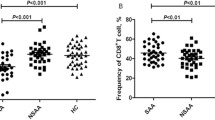Abstract
Objective
To investigate the expression of lymphocyte activation gene 3(LAG3) on CD8+T effector cells (Teffs), CD4+ Teffs and regulatory T cells (Tregs) in patients with severe aplastic anemia (SAA).
Methods
We detected the expression of LAG3 on CD8+ Teffs, CD4+ Teffs and Tregs in SAA patients and healthy controls (HC) by flow cytometry, and analyzed its correlation with the immune status and severity of the disease. ELISA was used to detect soluble LAG3(sLAG3).
Results
The expression of LAG3 on CD8+ Teffs, CD4+ Teffs and Tregs in untreated SAA patients were significantly lower than those in HC group (P < 0.05). After IST, the LAG3 expression of target cells increased to a level even higher than that in HC group (P < 0.05). LAG3 on T cell subsets was closely related to immune status and severity of the disease. The concentration of sLAG3 in these groups showed similar trends. LAG3 was not a prognostic factor of response.
Conclusion
The decreased expression of LAG3 on CD8+ Teffs, CD4+ Teffs and Tregs may be involved in the pathogenesis of SAA. LAG3 intervention may have therapeutic potential in treating SAA.




Similar content being viewed by others
References
Sun Y, Liu C, Shao Z. Advances of pathogenesis and genetic abnormalities in acquired aplastic anemia. Zhonghua Nei Ke Za Zhi. 2019;5(58):401–4. https://doi.org/10.3760/cma.j.issn.0578-1426.2019.05.015.
Liu C, Sun Y, Shao Z. Current concepts of the pathogenesis of aplastic anemia. Curr Pharm Des. 2019;25(3):236–41. https://doi.org/10.2174/1381612825666190313113601.
Goldberg MV, Drake CG. LAG-3 in cancer immunotherapy. Curr Top Microbiol Immunol. 2011;344:269–78. https://doi.org/10.1007/82_2010_114.
Bettini M, Szymczak-Workman AL, Forbes K, Castellaw AH, Selby M, Pan X, et al. Cutting edge: accelerated autoimmune diabetes in the absence of LAG-3. J Immunol. 2011;187(7):3493–8. https://doi.org/10.4049/jimmunol.1100714.
Durham NM, Nirschl CJ, Jackson CM, Elias J, Kochel CM, Anders RA, et al. Lymphocyte Activation Gene 3 (LAG-3) modulates the ability of CD4 T-cells to be suppressed in vivo. PLoS ONE. 2014;9(11):e109080. https://doi.org/10.1371/journal.pone.0109080.
Jha V, Workman CJ, McGaha TL, Li L, Vas J, Vignali DAA, et al. Lymphocyte Activation Gene-3 (LAG-3) negatively regulates environmentally-induced autoimmunity. PLoS ONE. 2014;9(8):e104484. https://doi.org/10.1371/journal.pone.0104484.
Woo S-R, Turnis ME, Goldberg MV, Bankoti J, Selby M, Nirschl CJ, et al. Immune inhibitory molecules LAG-3 and PD-1 synergistically regulate T-cell function to promote tumoral immune escape. Cancer Res. 2012;72(4):917–27. https://doi.org/10.1158/0008-5472.CAN-11-1620.
Marsh JCW, Ball SE, Cavenagh J, Darbyshire P, Dokal I, Gordon-Smith EC, et al. Guidelines for the diagnosis and management of aplastic anaemia. Br J Haematol. 2009;147(1):43–70. https://doi.org/10.1111/j.1365-2141.2009.07842.x.
Huard B, Prigent P, Pagès F, Bruniquel D, Triebel F. T cell major histocompatibility complex class II molecules down-regulate CD4 + T cell clone responses following LAG-3 binding. Eur J Immunol. 1996;26(5):1180–6. https://doi.org/10.1002/eji.1830260533.
Huard B, Tournier M, Hercend T, Triebel F, Faure F. Lymphocyte-activation gene 3/major histocompatibility complex class II interaction modulates the antigenic response of CD4 + T lymphocytes. Eur J Immunol. 1994;24(12):3216–21. https://doi.org/10.1002/eji.1830241246.
Xu F, Liu J, Liu D, Liu B, Wang M, Hu Z, et al. LSECtin expressed on melanoma cells promotes tumor progression by inhibiting antitumor T-cell responses. Cancer Res. 2014;74(13):3418–28. https://doi.org/10.1158/0008-5472.CAN-13-2690.
Kouo T, Huang L, Pucsek AB, Cao M, Solt S, Armstrong T, et al. Galectin-3 shapes antitumor immune responses by suppressing CD8 + T Cells via LAG-3 and inhibiting expansion of plasmacytoid dendritic cells. Cancer Immunol Res. 2015;3(4):412–23. https://doi.org/10.1158/2326-6066.CIR-14-0150.
Mao X, Ou MT, Karuppagounder SS, Kam T-I, Yin X, Xiong Y, et al. Pathological α-synuclein transmission initiated by binding lymphocyte-activation gene 3. Science. 2016;353(6307):3374. https://doi.org/10.1126/science.aah3374.
Wang J, Sanmamed MF, Datar I, Su TT, Ji L, Sun J, et al. Fibrinogen-like Protein 1 is a major immune inhibitory ligand of LAG-3. Cell. 2019;176(1–2):334–47.e12. https://doi.org/10.1016/j.cell.2018.11.010.
Yan L, Fu R, Liu H, Wang H, Liu C, Wang T, et al. Abnormal quantity and function of regulatory T cells in peripheral blood of patients with severe aplastic anemia. Cell Immunol. 2015;296(2):95–105. https://doi.org/10.1016/j.cellimm.2015.04.001.
Huang C-T, Workman CJ, Flies D, Pan X, Marson AL, Zhou G, et al. Role of LAG-3 in regulatory T cells. Immunity. 2004;21(4):503–13. https://doi.org/10.1016/j.immuni.2004.08.010.
Workman CJ, Vignali DAA. Negative regulation of T cell homeostasis by lymphocyte activation gene-3 (CD223). J Immunol. 2005;174(2):688–95. https://doi.org/10.4049/jimmunol.174.2.688.
Houot R, Perrot I, Garcia E, Durand I, Lebecque S. Human CD4 + CD25high regulatory T cells modulate myeloid but not plasmacytoid dendritic cells activation. J Immunol. 2006;176(9):5293–8. https://doi.org/10.4049/jimmunol.176.9.5293.
Liang B, Workman C, Lee J, Chew C, Dale BM, Colonna L, et al. Regulatory T cells inhibit dendritic cells by lymphocyte activation gene-3 engagement of MHC class II. J Immunol. 2008;180(9):5916–26. https://doi.org/10.4049/jimmunol.180.9.5916.
Zonghong S, Meifeng T, Huaquan W, Limin X, Jun W, Rong F, et al. Circulating myeloid dendritic cells are increased in individuals with severe aplastic anemia. Int J Hematol. 2011;93(2):156–62. https://doi.org/10.1007/s12185-010-0761-z.
Li N, Workman CJ, Martin SM, Vignali DAA. Biochemical analysis of the regulatory T cell protein lymphocyte activation gene-3 (LAG-3; CD223). J Immunol. 2004;173(11):6806–12. https://doi.org/10.4049/jimmunol.173.11.6806.
Annunziato F, Manetti R, Tomasévic I, Guidizi MG, Biagiotti R, Giannò V, et al. Expression and release of LAG-3-encoded protein by human CD4 + T cells are associated with IFN-gamma production. FASEB J. 1996;10(7):769–76. https://doi.org/10.1096/fasebj.10.7.8635694.
Buisson S, Triebel F. LAG-3 (CD223) reduces macrophage and dendritic cell differentiation from monocyte precursors. Immunology. 2005;114(3):369–74. https://doi.org/10.1111/j.1365-2567.2004.02087.x.
Delmastro MM, Styche AJ, Trucco MM, Workman CJ, Vignali DAA, Piganelli JD. Modulation of redox balance leaves murine diabetogenic TH1 T cells “LAG-3-ing” behind. Diabetes. 2012;61(7):1760–8. https://doi.org/10.2337/db11-1591.
Acknowledgements
This work was supported by the National Natural Science Foundation of China under Grant Numbers 81970116, 81770118, 81570111, 81870101; the Natural Science Foundation of Tianjin Municipal Science and Technology Commission under Grant Number 18ZXDBSY00140; and the Zhao Yi-Cheng Medical Science Foundation of Tianjin under Grant Number ZYYFY2019029.
Author information
Authors and Affiliations
Corresponding author
Ethics declarations
Conflict of interests
The authors declare that they have no conflict of interest.
Additional information
Publisher's Note
Springer Nature remains neutral with regard to jurisdictional claims in published maps and institutional affiliations.
About this article
Cite this article
Sun, Y., Liu, C., Jiao, T. et al. Decreased LAG3 expression on T effector cells and regulatory T cells in SAA. Int J Hematol 112, 757–763 (2020). https://doi.org/10.1007/s12185-020-02966-y
Received:
Revised:
Accepted:
Published:
Issue Date:
DOI: https://doi.org/10.1007/s12185-020-02966-y




